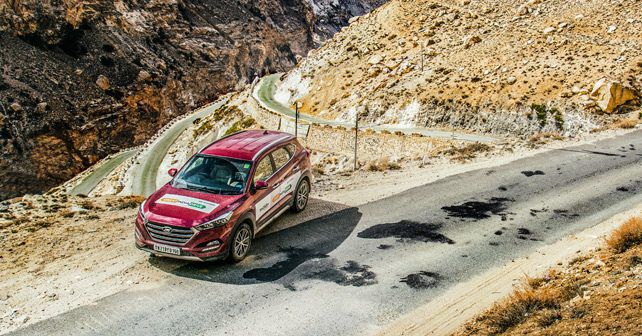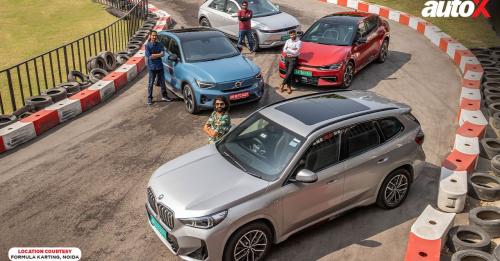As Hyundai kicks off the second edition of the Great India Drive, we take a Tucson across mountains and through high-altitude passes in search of snow. However, amidst a heatwave, it proved tougher than we expected.
For a nation that features a wide variety of terrain, seasons and natural diversity, we’re still obsessed with views of snow-clad mountains. But, if you think about it, this is probably understandable considering the weather conditions most of us brave throughout the year – for the majority of India, summer is long and brutal, and so finding better weather tends to include mountains in some way shape or form.
So, when Hyundai suggested that we drive off in the new Tucson from McLeodganj, my natural reaction was to embark on the hunt for some snow. This would serve two purposes – one, provide some respite from the heat, and, two, allow me to truly test the capabilities of the Tucson, which is perceived to be more soft-roader rather than a hardcore SUV.
Up in the air
The plan also included indulging in some adventure activities along the way. So, on the first leg of the journey, we headed towards the paragliding paradise of Bir-Billing. Largely regarded as the best paragliding destination in India, and situated at an altitude of 8,000 feet, it’s even been the venue of the Paragliding World Cup. Paragliding here involves unbeatable Himalayan vistas, coupled of course with the adrenaline-filled experience of soaring through the air. But, the real adrenaline-pumping moment of paragliding is not the view, or even the experience of driving up from Bir and gaining over 3,000 feet in altitude over a stretch of 14-odd kilometres. The real rush comes when, once strapped into the parachute harness, the instructor asks you to run for your life – and you ask, run where? That’s when it dawns on you, that you must take a leap of faith – literally – and run off the cliff to get airborne. Of course, your life flashes before your eyes as you imagine what would happen if you didn’t actually accumulate the requisite momentum to take off. But I mustered the courage to take the plunge, and, after a few moments of anxiety, there we were – up in the air and gaining altitude.
Having spent a good 30 minutes in the air, admiring the unspoilt scenic wonders, we finally descended into Bir Valley. The task for us now was to decide where our next destination was going to be for our first night halt. Given our route, it seemed best to head to Mandi, which was a couple of hours away, and park ourselves for the night as decent hotels after Mandi were quite a distance away – and we didn’t want to drive at night in the hills. The next day we would be carving through some pretty narrow roads to head to Jalori Pass – where we were hoping to catch some snow – en route to Rampur Bushahr.
First signs are positive
After an early morning start from Mandi, and good highways for the first couple of hours, the roads changed from wide two-lane highways into single lane, narrow, winding stretches of tarmac. With the river Beas flowing alongside, these roads were brilliant to drive on – aided by the fact that there was little or no traffic on our route. While pushing the Tucson to its limits on these winding roads I got a sense of the dynamic capabilities of this car. The benefit of it being more attuned to on-road use meant that I could brake later, rely on the Tucson’s cornering capabilities, and carry speed into corners. And, because of its monocoque construction, I could feel the car being rock solid at both low and high speeds. The six-speed automatic gearbox also works very well, and, for added response when climbing, I switched to sport mode – which sharpens the throttle response and hold gears for longer.
Luck wasn’t in our favour however, as we reached Jalori Pass. Situated at an altitude of 10,800 feet, the Pass had a tiny smattering of snow. So, our first destination turned out to be a damp squib. As we neared Rampur, I went into a flurry of phone calls to find out what would be our best option. And the verdict was unanimous, we could try going up to Nako, towards Spiti Valley. Or, we could try the rather anonymous Chanshal Pass – which had received a huge amount of snow a few days ago. Betting on the safe option, we embarked on yet another early morning start towards Nako from Rampur.
Climbing further
The next day, starting out in the dark before sunrise, another quality of the Tucson came to the fore – the LED headlights, which really do light up the road and aid visibility. But what lay ahead was a gruelling 16-hour day. But there were some surprises in store for us. First, there were no roads most of the time – they went from winding and smooth to none at all. Of course, blue skies and the beautiful Himalayas were great companions throughout.
However, we did face another peculiar problem. Since it was off-season, we couldn’t find any dhabas that were open. So, most days, we survived on a steady diet of chips, biscuits and chocolates, with the only solid meal being dinner! In fact, while on the way to Nako, we had to stop and ask the ever-dependable Indian Army about where we could get something to eat. Thankfully, the camp had a bakery open to the general public that served some fresh aaloo patties. Man, a snack has probably never tasted as good as those patties did in near freezing temperatures!
But, this day too proved to be another damp squib. Nako didn’t even have a wisp of snow around it. In fact, Jalori Pass had more snow even though Nako is at a higher altitude of 12,000 feet. However, there was some solace in the loops at Nako. Located on the way from Pooh to Nako, the switchbacks are a gorgeous ribbon of tarmac carved along the mountainside. So, despite there being no snow, I was a happy man as I got to enjoy the loops with virtually no traffic to speak of.
Retreat
With sunlight fading fast, we decided to head back to Rampur. From what we’d heard, there was no snow at Tabo, or even further. So, it made the most sense to go back to Rampur and try Chanshal Pass the next day. But, given our luck, the day wasn’t going to get any easier – it started pouring as we neared the turn off for Reckong Peo. We were still a good three-and-a-half hours away. So, amid non-existing roads, and in the pitch dark, we started pushing towards our destination – with the Tucson once again providing confidence thanks to its unflappable dynamics, despite the torrid conditions and limited visibility.
So, late at night, after a good 16-hour day of driving, taking pictures and shooting video – sans food, mostly – we reached our hotel and crashed as soon as we checked in. I was disappointed though, it had been multiple days on the road and I was no closer to fulfilling the goal of my journey. But, as I listened to the pouring rain pelting the windows and the thunder rumbling as the night progressed, there was one thought that lingered in the back of my mind – with this much rain and thunder, the high-altitude areas were bound to be getting some snowfall. Once again, there was hope – which is our biggest strength and weakness – and it egged me on to continue our search. I’m not easily defeated, and clearly the Tucson isn’t either…
To be continued…











































Write your Comment